AUTOMATIC ENTRY GATES
PERSONAL INJURY & DAMAGE CLAIMS
Download PDF of this article here
By Michael Panish
Door & Gate Expert Witness
A comprehensive look into automated entry gates, gate injuries, gate maintenance, and gate service providers. How to determine responsibility of involved parties and understand what leads to a claim. Specific technical aspects associated with motor controllers and gate functions are intentionally omitted from this article. This article is not intended to be a training manual for automatic gate operators for the general public. It is derived from many years of personal experience as an installer, service provider, and retained gate expert witness.
Introduction:
Property entry gates that are automatically operated by adjacent motor controllers are responsible for a myriad of different types of claims ranging from vehicular damage to wrongful death.
In this article, generic automated motor controlled devices and related triggering mechanisms will be explained, products and their applications and installations will be examined, and reasons for injuries and property damage will be explored. Requirements for service providers and service contract agreements will be addressed. Personal injuries associated with both defective and properly working gate products will be discussed.
Typical gate injuries and property damage occur in a variety of ways. It is not uncommon to have a swinging, sliding, or pivoting gate come into contact with a vehicle in the gates path of travel. Many personal injury and property damage claims have arisen from physical contact with a PROPERLY operating gate system or the way that the particular gate system is used or abused. Other personal injuries and wrongful death claims have been the result of an IMPROPERLY maintained and malfunctioning gate system.
Two distinct categories of damage and injury claims can result from either PROPERLY operating and functioning systems or IMPROPERLY and unsafely maintained systems.
PROPERLY OPERATING GATE SYSTEMS
Property damage or personal injuries resulting from inappropriate usage of a properly operating gate system. Three examples of different types of incidents that can occur due to poor personal choices.
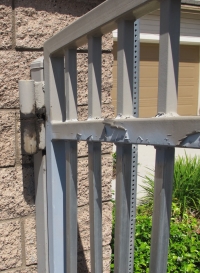
- Multiple vehicles attempt to exit a parking gate designed for single vehicle function. The subsequent vehicle, sometimes referred to as a "piggy back", attempts to exit through a gate that is set up to allow only one vehicle to exit with each cycle. The gate closes on the unauthorized car and damages both the vehicle and the gate system.
- A pedestrian attempt to enter an area through an already moving closing gate meant for vehicles only. The gate makes contact with the pedestrian, continues to close and severely injures the person as the closing cycle is completed.
- An uninformed or unaware workman fails to disable a motor controller. An irresponsible action of a person in close proximity to an automated gate or operator mechanism is severely injured, crushed, or killed. Inappropriate entanglement with a properly functioning gate mechanism is usually directly attributable to the personal responsibility of the injured party.
IMPROPERLY OPERATING GATE SYSTEMS
(Defective or deferred equipment)
Cosmetic indications such as peeling paint or worn out hinges (see photo to right) are usually good indications that the gate and related hardware are not being properly maintained. This is a superficial observation that often leads to finding more serious motor control deficiencies
If an injury or property damage results from deferred or defective equipment, one or all of the following three reasons may be observed.
- Improper choice of product, placement, or installation.
- Missing safety devices or required code compliant practices.
- Long deferred maintenance of the gate system and associated related products.
Requirements for an initial evaluation:
As a retained gate expert witness for either plaintiff or defense, an unbiased assessment of the site is essential. The most important aspect of a thorough field examination is possessing the trade specific knowledge for all of the possible devices that can be used with the subject gate controller. Secondly, a true gate expert must have the ability to identify all of the equipment components that are present and be able to verify their condition and functional capabilities. It is important to approach each inspection with an open mind. Some so called experts offer predetermined and tired opinions based upon their own bias and limited knowledge and expertise. An expert must positively know if the motor controller is properly installed and that all of the products associated with the controller work and are correctly adjusted. The expert must have a thorough understanding of all of the current available safety features, determine if they are in place, verify that they are properly functioning, and appropriately integrated. Maintenance and service records, if available at the time of, or prior to the site inspection, can prove important and be significant in determining the cause of an incident. These records can also help make clear which service entities or owners may be associated with or responsible for the claim.
What makes up a typical gate system?
In any gate system there has to be a gate of some sort. It can be installed to either swing or slide and it can operate horizontally, vertically or in some combination of both motions. Gates can be moved manually or have automatic motor controls. Most vehicular gates operate using some sort of automatic motor controller. They allow an ease of access and are safe to use if properly installed, maintained, and are functioning correctly. If the motor in place is not working and it has been properly disconnected from the gate, manually pushing a rolling or swinging gate can be safe if it was properly manufactured, installed, adjusted, and balanced.
HOW DO AUTOMATED GATES OPERATE?

When gates have installed automatic motor controllers, they require either remote or local activation devices. Some of the most typical activation devices may include hard wired phone lines between a residence or office and the gate.
Architectural pedestals with wall mounted activation keypads or magnetic card readers are common. Other devices with electronic interfaces capable of energizing the controller, such as hand-held or car equipped radio activated remote controls perform the same function as the hard wired command system, only wirelessly.
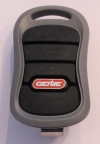

In this day and age, many smart phones can be used to open and close automatic motor controllers remotely. It is now possible to monitor the function and position of most automatic motor controllers online. An owner can remotely unlock or activate an automated gate from anywhere in the world to allow user access with a few simple commands on their smart phone or computer. Magnetic inductance ground loops are also installed into many automatic gate systems.
Using any single device from the above list causes the gate motor controller to begin operating. Many times, the starting operation of the motor controller occurs without any advance warning once it has received an activation command. In some circumstances, audible or visible alarms indicate that the motor controller is about to become active. These alarms are more common in a commercial setting where cross traffic needs to be made aware of potential gate operations prior to the operator start up. But, in many cases, alarms are a false sense of security and are generally ineffective as there is usually not enough time for reaction when the alarm is heard or seen.
In ground activation sensors:
In high usage systems, in-ground sensors commonly referred to as control loops are frequently placed below the surface of concrete or asphalt adjacent to the gate. These in-ground loops are fabricated from various gauges and configurations of insulated wire that create a magnetic inductance field. The magnetic field is usually controlled and generated through electrically charged modules attached to the gate operator motor control unit.
When a car or truck drives over these ground loops the metal of the vehicles alter the magnetic field of the ground loop. The vehicle presence lengthens the path of the magnetic field to "notify" the motor controller that a vehicle is in proximity to the in-ground loop. In some systems a base line frequency becomes altered by the presence of the now detected metal of the vehicle. Loops are often positioned in multiple locations near the gate and offer several different functions to protect the vehicles as the vehicle transitions from "approaching" the gate, passing over the "threshold" of the gate, and "clearing" the gate. Years ago, pressure sensitive pads were tried as triggering devices. These products were prone to false readings and failed after a short period of installation usage. It is a common misconception that modern control loops are only activated from the weight of a vehicle.
In-ground loops require routine analysis for continuity and condition. Damage due to corrosion by chemical reaction of the insulation of the wire loop and roadbed material can create changes in the activation fields of these magnetic devices or cause them to fail completely. Sometimes, weather conditions are also responsible for improperly working sensor loops. Temperature, snow, ice, and water can lead to defective operation of a deferred control wire loop that has lost insulation qualities. These loops need to be checked using a specific piece of equipment referred to as a "meg" meter that is designed to measure the magnetic inductance. A competent service provider must use this "megohm" resistance measuring equipment and understand what the readings mean. Generally, low or inconsistent readings indicate that the loop must be replaced. Mid-range readings usually indicate a working loop. There are various ranges on the meters which are used to verify the overall loop responses which are chosen depending upon the size, length, and gauge of wire installed in the ground
.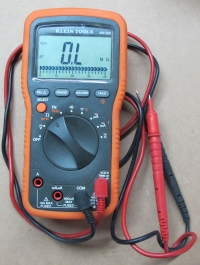

The multi-meter (above) has a resistance setting to measure ohms. This is a typical type of (megohm) measuring device capable of applying voltage to an in-ground loop.
This view of the electronics in a typical gate operator (above) shows three installed modules that are attached to the in-ground loops.
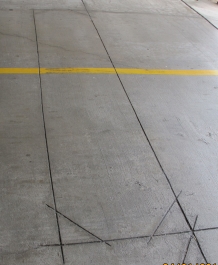
The actual wire ground loop installed in this driveway (above) is not visible. The saw cuts indicate that a small trench has been made to place the ground loop wire. Typically, the clipped or rounded corners and trail show the position of the loop. In many cases, additional loops have been installed due to improper original placement of the in-ground loop. It is important to verify which of the trenched ground loops are currently connected to the motor controller.
Adding safety features:
In addition to the various activation products, there are many different kinds of ancillary safety products manufactured and readily available for automatic gate controllers. At times, wrongfully considered as an optional piece of equipment, these products provide functions designed to protect users from inadvertent gate operations and adverse forces that can be potentially imparted to the gate via the motor control mechanism.
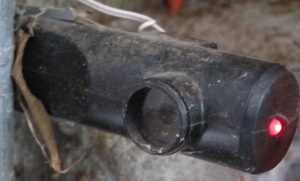
One of many styles of optical sensors available (above),
added as additional safety for some gate installations.
In the most basic motor controlled system an activation command to open the gate is the single "trigger" for the motor. A built-in and field adjustable timer is used to control the closing function of the gate motor control. After the initial activation to open the gate, the timer begins "counting down" until it reaches zero and allows the gate mechanism to close the gate. This type of minimal circuitry is from a time when no safety devices were thought of as necessary, and is currently significantly below acceptable standards for safe gate operators. These products are still in usage throughout the country as the motor controllers are still in operable condition and have not been upgraded.
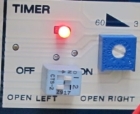
One of many timer styles of control elements of a typical basic
gate operating system (left)
For purposes of this article, but not universally applicable, gates and their motor controllers are essentially "blind" mechanical devices. Without any added motor controller safety equipment monitoring obstructions in the path of travel of the gate, the potential for serious physical contact between a moving gate and vehicles or pedestrian is probable at some time.
Typically, local codes, national standards, and professional installations require factory available safety accessories be added to the basic motor controller equipment. Some of these products include photo electric beams, the aforementioned in-ground control loops, microwave, infrared and ultrasonic sensors, and auto reverse circuits with adjustable sensitivity.
Built in slip clutch mechanisms are part of some motor controllers which can limit the movement of the driven gate. It is important to understand that "slip clutches" are primarily incorporated into most mechanical devices to protect the mechanism. Slip clutches are not safety devices meant primarily to protect a user. They are in place to keep the mechanical operator from destroying itself when adverse resistive forces are encountered. There are manufacturer notes provided in most installation manuals that clearly state that the slip clutch is not a personnel safety device and should not be used in place of appropriate safety devices that are available and intended for increased safe usage of the operator.
Failing to install any available safety equipment is not acceptable from any professional service provider. Even though many service providers do not do so, every gate that has an automated control system, and is contracted to be professionally inspected, should be brought up to the most current standards available. Safety should always be the paramount consideration when any automatic gate system is professionally evaluated. Gate service providers must inform the owner of every automated gate that any substandard conditions exist, or risk being responsible for potential claims that may arise.
WARNING LABELS & SIGNAGE

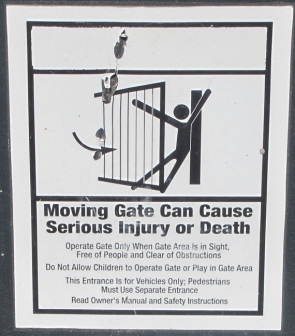
Manufacturer designed signage that usually accompanies the gate motor controller is often not enough to inform users of the real potential dangers. That does not make the manufacturers responsible for gate and motor controller injuries in any way. Warning signs provided by the manufacturer are the final attempt by the manufacturer to inform the general public that there are inherent, and generally reasonable acceptable known operating dangers associated with their products operation.
It has been my experience as a door and gate expert witness that signage on moving doors and gates goes unheeded by most people. They either do not pay any attention to the information, fail to recognize that they are being instructed and need to pay attention, or simply do not understand the inherent danger of a heavy moving object. In several previous personal injury gate cases, signage has been installed on one side of a gate, and was never seen by the injured party that was on the other side of the gate. Past cases have also included injuries to young children that could not read or understand warning signs even if they had been appropriately and redundantly positioned. Warning signage does not make a moving object safe. Signs offer some advance notice of potentially dangerous conditions, but cannot take the place of vigilant parental supervision of young children or personal responsibility in competent adults. In many gate and motor controller personal injury and wrongful death cases, there is a strong and significant component of responsibility directly linked to the injured party.
How to explain impact force:
Many large wrought iron vehicle gates can weigh in excess of 1000 pounds.
Since force equals mass times acceleration, a half ton gate can impart
many times its' own physical weight, due to the properties we should
have all learned in basic physics classes. If you calculate the weight
of the gate plus the speed of travel provided by a malfunctioning motor
controller, you can quantitatively identify the force at impact. These
calculations are not always necessary as a claim for defective operations
becomes apparent when a vehicle has been dented or a pedestrian has been
hit and injured.
Why the gate was able to make contact is what matters.

A typical highly ornamented sliding wrought iron gate system.
This gate is operated by a chain driven operator.
Note: the bronze cover of the gate operator and the gray colored disconnect
switch in the lower right hand corner of this picture.
GATE MOTOR CONTROLLERS
Most gate motor controllers function using one of two types of motivating systems
A direct coupled mechanism:
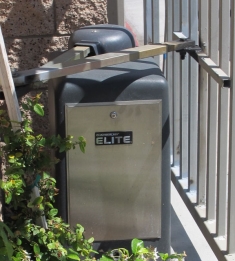
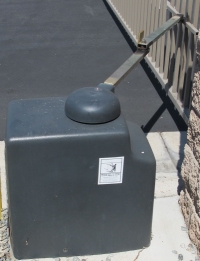
Two examples of a gate operator that is directly coupled to a swinging gate. Note: the arm and elbow that folds andextends as the gate is opened and closed. This arm operation can be dangerous to a worker or pedestrian and cannot be completely enclosed due to the operational requirements of the motor control mechanism. Note: the manufacturer supplied white label on the operator cover warning anyone in proximity of the dangers associated with this device.
Swinging gates that have arms attached between the motor controller and gate are an example of a directly coupled mechanical system. Often these type of motor controllers utilize a revolving control shaft that has an arm connected to transfer the power of the operator in a linear fashion.
Due to the necessity of installation, elbow like joints attached to control arms are needed to allow movement of the gate. Pinch points and crush zones are common as a result of the mechanical movement of these products. Warning labels positioned on the controller housings alert workmen and the general public in proximity that a potentially hazardous condition can occur. It is essential that anyone approaching the gate and operator be aware of the immediate potential for operation without any warning. Failure of workers to take appropriate precautions and "lock-out" or turn off the operator has resulted in severe injuries and death claims. Failure to heed the applied warning labels have resulted in a variety of injury claims by the general public, including death. It is almost impossible to safeguard these automatic devices beyond warning labels as movements of the arms and motor controller must happen to operate the gate. Strong resistive movements are needed and expected to motivate the gate operation. There are no safety devices designed to counteract forces of the primary gate controller as no personnel should be lodged within the path of travel of the operator mechanism at any time. I have never seen an installation where it has been possible to completely enclose all of the components of the gate and operating arm to protect a person from harm that was within the zone of operation. No matter how ingeniously designed the installation, there are still required areas of movement of the motor controlled equipment that can potentially entrap, entangle or crush an unauthorized access of an individual.
Chain driven mechanism:
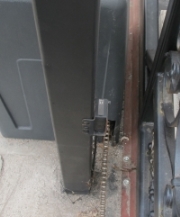
This photo (left) shows a chain driven gate. The chain in this device either passes over a driven pinion gear or coils and uncoils as the gate travels. Note: the small bracketed device directly above the chain on the pole. This is one example of a cross threshold beam emitter designed to safeguard the threshold of the gate.
In general, chain driven equipment is usually installed on sliding gate systems. There are at least two different methods used to convey the gate. In the first system, a small gear rotates engaging the links of the chain. This gear moves the chain back and forth without capturing the links. The chain remains attached to the full width of the sliding gate and is permanently anchored at both ends of the gate.
There are several ways that the position of the sliding gate is determined. A couple of examples are as follows. Tactile or electronic contact limit switches are attached to each end of the moving gate. When either of the two limit switches makes contact with a fixed tab or magnetic plate, the motor control is sent an electrical pulse that turns the motor off. Another way that gate position is controlled has to do with using rotational counter technology. When installed or serviced, the motor controller is set so that there is a certain number of revolutions of the control gear mechanism that are internally counted. This can be set mechanically with positioning collars or electronically with a digital counter
. This threaded rod and the adjustable nylon wheels set the limits of travel
in some gate motor controllers.
This threaded rod and the adjustable nylon wheels set the limits of travel
in some gate motor controllers.
A second type of chain drive mechanism actually captures, spools and unspools the chain as the gate is moved open and closed. This type of controller is more expensive, complicated and requires more maintenance than the first mentioned product. Travel of the gate is often electronically monitored, and has more precise capabilities for movement and obstructive safety.
Building code revisions:
Over time, and in a reaction to prior crush injury cases, building codes have changed in an attempt to address crush zones and problematic component placement. In some locations and configurations, installations that have been in place and functioning properly for many years, are now considered substandard to current codes. That does not mean that an installation has to be removed and reworked to bring it up to a code standard that did not exist when it was fabricated and installed. This condition is commonly referred to as "Grandfathering". Unless a complete renovation of the gate system is made, and pending local authority oversight and approval, previous existing conditions are generally left unchanged and remain acceptable. Current building code requirements are usually not the same as current safety standard requirements. Safety standards are generally more quickly adopted and available to trade professionals than building code revisions. Many times, current code compliance has no connection with the type of incident created by the deferred or improperly functioning gate system components.
An example of a type of code change condition involves the placement of a swinging gate hinge point. Gate hinges were once frequently positioned on the centerline of a column for aesthetic reasons. Newer revisions to some building codes attempt to improve or limit a crush point by moving the gate hinge location to the edge of a column. This position change has not always worked as hoped. In certain claims, crush points of code compliant gates have still existed due to inappropriate usage and poor choices made by individuals. As to what is considered a "code compliant or standard compliant installation", I have repeatedly observed in many past cases that modern codes do not make all situations safer than older codes. They do not guarantee that strict compliance and observation of the new code will prevent or stop some incidents from occurring.
How gates are usually maintained and professional service providers are hired:
In many previous cases where I have been retained as the gate expert witness, it has been found that large and small organizations such as national store chains and homeowner's associations rely solely upon a single service provider to inspect, maintain and service their gate systems.
Many service companies entering into a contract with these entities have provided promises, advertised and claimed that they are proficient and have the required expertise to maintain a gate system. However, it is frequently found that the gate service provider has failed to provide quality professional services that meet any professional standards.
Some service providers ignore the potential dangers that are possible with any automated products thinking that the gate operator is a rather uncomplicated device. This is generally due to inexperienced or poorly trained "technicians" who do not understand the complexities of the gate systems. These incompetent workmen make wrong decisions about the condition of the various gate components when they are sent to inspect and provide preventative maintenance service. Their lack of skills and inappropriate training have been recorded in numerous deposition transcripts I have reviewed.
Often, the training that has been given to these workmen consists of little more than following around another workman for a couple of days or weeks. Depending upon the level of training the first worker had, and whether or not the next worker understood what he observed, the subsequent generation of workman may be watching techniques and following procedures that are completely wrong. Those incorrect procedures are than incorporated into the service techniques of the next generation and the next generation of workmen. Using a service provider that has "trained" the workmen in this haphazard manner will not guarantee that the service work is appropriate, trade specific, manufacturer approved or yield a result that is safe for public usage.
In one claim brought against a service provider, he insisted that magnetic loop readings of around "0" were insignificant when determining that in-ground sensor loops were malfunctioning. He boldly and ignorantly continued to support his opinions with additional comments in his deposition that he had seen many low loop readings in other systems, and in his opinion they had worked fine.
An actual reading around "0" means that the loop is not working. The service provider stated that "his company owner had taught him that the loop device was still working properly regardless of the reading when tested. The only real test was to see if the gate opened and closed when he drove his truck onto the loop."
What should a property owner know and require when looking for a gate service provider?
Prior to entering into an agreement with a gate service provider, several issues need to be verified to protect the property owners and the end users of the gate.
- As a gate company, does the potential service provider have the needed expertise and ability to determine the overall existing condition of the gate system?
- Is the potential service provider a fence installer that can offer automatic gate service, or a professional automatic gate installer that also provides fencing?
- Does the service provider have qualified personnel that will be able to make repairs and determine that the gate meets all required safety standards at each service?
- Does the service provider work in close proximity to the general area specific to the subject property so that references can be verified as to quality of service, response time, and overall reliability?
- Does the service provider have appropriate liability and workmen's compensation insurance coverage? Can, or will, the company offer complete indemnification to a property owner or organization if an accident resulting from the gate that is being serviced occurs?
- What type of maintenance is needed?
- What service intervals will be instituted?
- What condition and standards will the gates be maintained to?
- Is every component of the gate system evaluated at every service? If multiple gates are on the property, will all gates be inspected at the time of the service call?
- Will the service technician provide thorough documentation of all service work and recommendations?
- What is the cost associated with every part of the contract?
- Are emergency calls included at a regular rate or is there an increased price?
- How long should the response time be for a needed repair, including the availability of replacement equipment?
- Does the service provider maintain components in-stock relevant to the gate system of the subject location?
- Are any supplemental services required by any other outside source that the gate service provider cannot offer?
In general, any gate contractor that offers an ongoing maintenance program as the sole service provider becomes responsible for many aspects of the gate system. If an organization or owner relies upon that sole service provider, follows all suggestions made by the sole service provider, and agrees to pay for all needed upgrades and repairs, that service provider is considered the responsible entity for gate performance. In the event of an incident that leads to personal injury, wrongful death, or property damage, the owner of the property will probably be held responsible. However, the insurance policy certificate with a designated service provider should include indemnification and ultimate responsibility for the occurrence as part of the relationship agreement between the two parties.
Normally functioning gate equipment causes personal injuries due to improper
professional conduct:
In several prior cases, workers in proximity to a swinging or sliding gate operator have become entangled and crushed by the motor controller and the action of the attached motive arm or drive chain mechanisms. In at least three prior cases, gardeners, attempting to trim plants near the gate motor controller were crushed or injured when a remote control device activated the gate motor while they were standing within the path of travel of the gate arm. All three cases occurred within direct visual sight of the motor controller power switch.
In another trade related accident, a plumber was attempting to access sprinkler pipes when he was struck by a moving gate that had been activated remotely from the adjacent residence. The homeowner failed to disable the gate operator, and forgot that the plumber was working within the path of travel of the gate.
An electrician that had previously installed the power to the motor controller failed to provide an emergency local disconnect switch at the time that he hooked up the motor controller. This lack of electrical code compliance actually cost him his right arm. Several years later, the gate began moving as he was working near the gate controller. He was knocked off of his ladder as he was attempting to service a lamp fixture mounted on one of the masonry columns where the gate was hinged. The electrician became tangled in his ladder, and the force of the swinging gate crushed his arm as the ladder fell with him into the operator mechanism.
All of these aforementioned accidents were the result of careless workers near the gate motor controllers. It is well within a reasonable standard of care to have a worker in proximity to any moving device. Knowing that a motor can start without warning means that the worker must positively know that the gate is disabled while they are working in the area. Personally failing to take precautions to assure that the motor controller is deactivated is the direct responsibility of the worker, and indirectly the responsibility of the property owner or the worker's manager.
In a couple of these claims, the homeowner was found to be responsible, as the workers were directly employed by the homeowner. In the case of the plumber and the electrician, they were independent workers that were responsible for their own actions, and they were found to have contributed to the incident.
In other cases, severe injuries and even deaths have occurred when people were playing around moving gates and control mechanisms. People have become entangled when they have insinuated part of their bodies between fixed structures and moving gate control arms. Due to the required actions of the door controllers, it is essential to have anyone working in the area "lock out" and make certain that the door controller power is turned off prior to working near the gate and control arm. People have also been run over or dragged by a chain driven gate because the mechanism was not deactivated.
There are no requirements that mandate any fencing or caging to protect someone from a motor controller inadvertently starting, other than labels positioned on the motor controller cautioning people regarding potential movement of the mechanism and gate. In most cases, it is not possible to enclose a motor controller and gate arm to guard against an injury. The gate arm requires a certain path of travel to perform the job that moves the gate. Any restriction or coverage of the control arm would not protect someone if struck by the gate or if improperly positioned between the motor controller and adjacent area because the gate arm must freely move to convey the gate. There are certain types of injuries that occur as a result of poor judgement, inappropriate training or lack of adult supervision.
EXAMPLES OF GATE INJURY CLAIMS:
An elderly woman walking through the vehicle gate in her condo complex
The woman saw a car approach the sliding gate, the gate opened, she attempted to cross from the exterior into the parking garage when the gate rapidly closed and broke her leg. In this case, there were no optical sensors, no activation loops, and the gate motor control was simply used as a timing device. The gate closed rapidly due to inappropriate speed adjustment settings. There were signs pointing out an adjacent pedestrian gate, but the woman failed to understand the information or chose to not heed the provided directional signage. She saw the open vehicle gate, and opted to walk through it. A video camera used for the parking lot security captured the entire incident showing what had happened.
In this claim, the gate service provider had recently worked on the gate, and in an effort to appease the condo board of directors to keep multiple cars from "piggy backing" while entering the parking garage, the repairman had accelerated the closing cycle of the gate, making for an unpredictable and inconsistent closing time. The condo association was found to have been negligent because they had made the decision to alter the normal functions of the gate controller, and the service provider was also found to be responsible due to the obligation to maintain appropriate manufacturer safeguards. The woman that used the vehicular gate instead of the pedestrian access was also found partially responsible for her own injuries.
A condo association hired a local gate and fence company to automate existing
entry gates
in the complex
From the condition of the equipment at the time of my inspection, it was
obvious that the motor controller had never been serviced or maintained
since the original installation of that equipment. Due to the beach location
of the condo complex, the gates and controller deteriorated rapidly, and
rust had caused the control arm to bend and change the gate operating
functions. The overall deferred condition of the gate system led to a
high value vehicle damage claim made by one of the home owners living
at the condo complex. Rather than accept the deteriorated condition as
the reason for the damage, the homeowner's association sued the fence
company in an effort to transfer responsibility for poor maintenance practices
on the part of the condo association. During early discovery, the gate
and fence company provided documentation that proved it had offered a
service plan to this condo association, had offered to provide routine
maintenance, which were declined due to the proposed costs. The service
provider was released from the claim after an initial inspection report
was submitted.
An apartment resident was exiting an underground parking lot when her vehicle
was struck by a rapidly closing overhead gate
There were safety beams in place to protect the opening, and there was another car ahead of her that was waiting for the cross traffic to clear. As the first car exiting left the threshold, the next resident (the subject of this claim) moved into position to await a break in the cross traffic. As she was waiting, the overhead gate descended upon the hood and windshield of her car shattering the glass into the passenger compartment. The event startled the driver, and she stomped on the gas pedal, causing the bottom of the gate, which was now resting inside her car, to travel further into the vehicle, and trapped the woman between the gate and her driver seat. She suffered head and neck injuries and was hospitalized. During my site inspection, it was determined that the cross threshold beams were inactive. The control wire was cut. The motor controller was not receiving any information from the beams, and as the controller was older, did not have a failsafe device installed that would require that the safety beams were integrated and functioning properly in order to operate. When the door controller timed out, the gate closed as designed. Additionally, the gate motor control was out of adjustment, and the gate closed more rapidly and with greater force than it should have. There was also an improperly functioning automatic reverse function. So, two of the potential safety features (cross threshold beams and an auto reverse mechanism) that would have prevented this incident were missing or broken. The apartment ownership admitted during discovery that the device was old, had not been maintained, and made no attempt to fight the claim.
Man is struck by an overhead garage gate
A man was attempting to exit the garage of his apartment complex by the only egress possible. It was a gate shared by vehicles and pedestrians when leaving the interior side of the parking area. He had pushed the garage controller from his car to activate the gate opener, and was attempting to cross the gate threshold when the gate swung down rapidly.
There were safety beams connected to the motor controller, only they had been installed upon the wall approximately 8 feet above the ground. They were spaced approximately 1 inch apart, so that the beam could not be interrupted. They had been intentionally wired together, facing one another, to allow the gate operator to function. The cross threshold beam sensors had never been installed correctly to protect the threshold of the doorway where they belonged. It was discovered that the original installation of the gate took place many years prior. Nobody from the management of the apartment building had ever checked that cross threshold sensors even existed on this gated opening.
Apparently, in an effort to make the gate operator function, the past installers had failed to properly install the cross threshold beams across the threshold of the gate opening. By hanging them on the wall rather than make the effort to properly position and wire them at ground level the beams had been wasted as the provided safety device. The apartment management was found responsible for the injury due to their lack of inspection of the gate system.
Automatic gates routinely operate on a daily basis across the country. Most automatic gate operators function safely without incident. The manufacturers of the control motors provide a reasonable degree of care to make certain that the operation of their products can be safe for all users. New gate operators are manufactured to industry approved standards, and older operators should be made current standard compliant through repair and maintenance service work. Injuries and property damage that occurs are generally due to improper installation methods, deferred maintenance, or carelessness of individual users. Lack of personal awareness and individual responsibility cannot be overlooked in some injury claims.
There are always extenuating circumstances to every case, and no two cases are completely alike. As an unbiased expert working for both plaintiff and defense, my opinions are applicable to both sides of every case. Reasonable usage of a well maintained automatic gate is generally safe. Poorly maintained gates and automatic motor controllers are generally unsafe.
Workers personal safety is paramount when working adjacent to any motor controlled device. Appropriate lock-out procedures need to be followed around any moving mechanical piece of equipment. Gate and motor control injuries to the general public, whether adult or child should never occur. Personal awareness, vigilance, and supervision should be enough to guard against most types of automatic gate injuries.
Other Gate Articles by Michael Panish
GATE & FENCE - Accidents and Injuries
Malfunctioning gates and fences can cause catastrophic and traumatic bodily
injury and death. Parking garage gates, pool fences, property fences,
drop down doors.
By Michael Panish
The Ups & Downs of PARKING CONTROL ARMS
What every attorney needs to know about how they function, why they fail,
and why someone got injured. Who is at fault, who is to blame, and what
the industry standards are that affect the claim?
By Michael Panish
MANUAL SWING BARRIER GATE INJURIES
More dangerous than you would think. Why have so many injuries occurred?
What are the reasons why these innocuous common devices have become life
changing instruments of despair?
By Michael Panish
Mike Panish provides his expert services for most types of automated doors
and gates. He has been retained on approximately 100 cases specifically
pertaining to automatic gate operators since the year 2000. He is currently
the retained expert witness on many gate personal injury and wrongful
death claims across the United States. His expert involvement is for both
plaintiff and defense. He is routinely called upon by major product manufacturers
to analyze injury claims from an independent and unbiased perspective.
He is well known, highly respected, and is established as the industry
expert of choice. It is not unusual for many parties in a claim to seek
his expertise. He has authored numerous articles pertaining to automatic
gate safety and related injuries. For a complete list of all of his expert
services, areas of expertise, and published articles visit his website
at www.constructionwitness.com.



